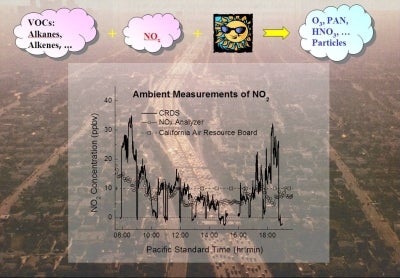Environmental chemistry research focuses on chemical processes that affect the sources, composition, reactions, transport, and fates of chemical species in natural environments (air, water, and soil), the impacts of human activities on these environments, and chemical aspects of pollution prevention and contaminant remediation. The common objective of the environmental chemistry research at UCR is to develop a fundamental and molecular-level understanding of the chemical processes in the environments and for environmental remediation. Projects include atmospheric measurements, atmospheric chemical kinetics and mechanisms, atmospheric aerosol chemistry, optical and electrochemical sensors for environmental water, fiber optic sensors for environmental pollutants, nanostructured materials for waste water treatment, porous materials for carbon dioxide sequestration and conversion, etc.
Environmental chemistry is a broad and highly interdisciplinary field. The environmental chemistry research at UCR offers broad trainings in atmospheric chemistry, physical chemistry, analytical chemistry, and materials chemistry. It also provides an opportunity for students to develop interdisciplinary research expertise via collaborations with Air Pollution Research Center, Department of Environmental Sciences, and Center for Environmental Research & Technology (CE-CERT).
Faculty Research Descriptions:
Christopher Bardeen
Our research focus is to develop chemical tools (i.e. fluorescent probes and photochemical genetics tools) that can be coupled with fluorescence spectroscopy and microscopy to solve problems in chemistry, biology and medicine. In addition, we utilize protein engineering and protein chemistry to generate molecular diversities, which are harnessed for new reagents targeting at critical therapeutic targets.
Quan Jason Cheng
The environmental chemistry research in the Cheng group focuses on development of biosensing technology for detection of pathogenic agents such as bacteria, viruses, and small carcinogenic molecules and ions in water and related environmental samples. We are particularly interested in optical and electrochemical approaches that allow rapid detection and self calibration. Our research also explores miniaturized sensing devices for measurement at a single cell level.
James Davies
Quantifying the evolving physical properties of aerosol particles as they are oxidized is crucial in predicting their influence on cloud formation, visibility and human health. Our work combines single particle levitation with analytical tools to explore the chemistry of aerosol and characterize the physical properties and characteristics of collected aerosol samples.
Pingyun Feng
Our research interest centers on the development of synthetic methodologies to prepare novel nanostructured materials and porous materials with applications in photocatalysis for carbon dioxide sequestration and conversion, fuel generation and gas adsorption.
Bryan M. Wong
The Wong group develops and applies first-principles, quantum-mechanical computational techniques to predict, understand, and rationally design chemical/material systems (either previously synthesized or yet to be made). Our motivation arises from a deep interest in electron dynamics – a surprisingly rich research area that centers on the non-equilibrium (i.e., time-dependent) electronic properties of systems. Our expertise in developing and applying new electronic structure and time-dependent dynamics techniques brings a new, unique capability for exploring these rich, emerging areas in complex chemical/material systems.
Yadong Yin
The Yin lab studies the development of novel nanostructured materials for environmental applications, including waste water treatment and clean and sustainable energy. We are also interested in developing environmentally friendly materials with reduced negative impacts to the environment.
Francisco Zaera
Our group is focused on the study of reaction mechanisms on surfaces at a molecular level. One of our interests is in the development of a better understanding of heterogeneous catalysts. We have done some work on the performance of the catalytic converter used in automobiles, focusing in particular on the chemistry associated with the reduction of nitrogen oxides on rhodium surfaces. More recently, we have embarked in a project to develop novel photocatalysts for the production of hydrogen, a clean fuel, from water. We are also interested in catalysts that can help develop greener processes.
Haofei Zhang
Our research focuses on understanding the multiphase physiochemical processes that lead to the formation and evolution of organic aerosol in the atmosphere. In the long term, we want to understand how organic aerosol impacts climate and human health.
Jingsong Zhang
Our research focuses on the oxidation processes of tropospheric volatile organic compounds (VOCs). We are interested in developing sensitive optical instruments for ambient measurements of atmospheric trace species and free radicals. We utilize multi-pass absorption techniques, cavity ring-down spectroscopy (CRDS) and cavity enhanced spectroscopy (CEAS), for these atmospheric measurements. We are also interested in laboratory chemical kinetics of atmospheric reactions. We use spectroscopy and mass spectrometry methods to illustrate the reaction mechanisms of tropospheric oxidation reactions of VOCs. These studies aim to provide reliable measurements of ambient trace species and free radicals, as well as basic understanding of the kinetics and mechanisms of atmospheric oxidation reactions. We are also interested in green house gas (GHG) measurements in California.

